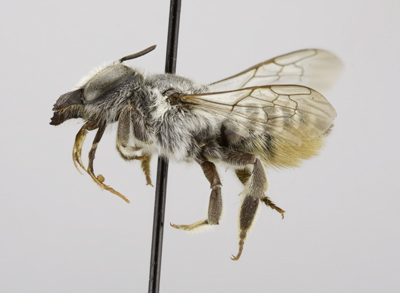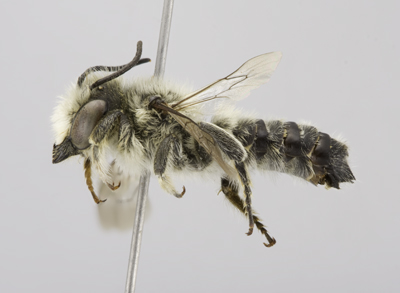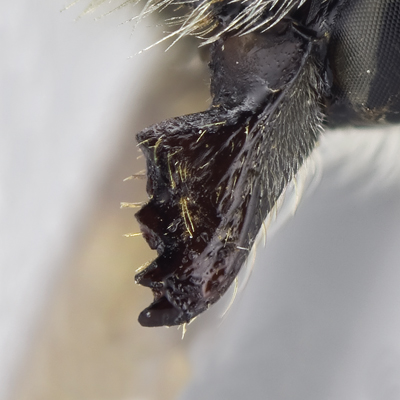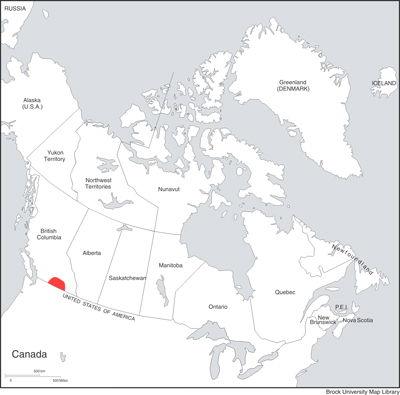
8. Megachile (Litomegachile) coquilletti Cockerell, 1915
Megachile coquilletti Female |
Megachile coquilletti Male |
Megachile mendica coquilletti Cockerell, 1915. Ann. Mag. Nat. Hist. (8) 15: 535 (♂).
Diagnosis.The female of M. coquilletti can be recognized by the combination of 4-dentate mandibles with the emargination between inner and 3rd teeth being approximately semicircular (i.e., its greatest depth subequally distant between the two teeth), T6 being weakly concave in lateral view, and S6 with scopal hairs entirely black. They are most similar to M. brevis and M. onobrychidis. Females of M. brevis are typically smaller, have T6 strongly concave in lateral view, and have mostly pale scopal hairs on S6. Females of M. onobrychidis are somewhat smaller, and have T6 strongly concave in lateral view. The male of M. coquilletti can be recognized by the combination of simple, yellow front tarsomeres 2‒4, front coxa possessing a small spine, 3-dentate mandibles with lower process present, T5 with a white apical fascia, T6 with the surface above carina with white tomentum dense and conspicuous medially, concealing most of the surface beneath. They are most similar to M. brevis and M. onobrychidis, and less so to M. ericetorum. Males of M. brevis and M. onobrychidis have entirely dark front tarsomeres. Males of M. onobrychidis have the surface of T6 above the carina largely visible, with very little white tomentum. Males of M. ericetorum are larger, have mandible without a lower process, and T6 without white tomentum above to carina.
FEMALE: Length 11-12 mm.
Head:
Figure M8: Megachile coquilletti female mandible |
1) compound eyes slightly convergent below, lateral ocelli very slightly nearer edge of vertex than eyes (4.5:6), 2) clypeal margin smooth and entire, 3) mandibles distinctly 4-dentate, with an incomplete cutting edge between the 2nd and 3rd teeth, complete between 3rd and 4th teeth (Figure M8), 4) gena slightly narrower than compound eye (7:9), 5) punctures fine and close on face, rather shallow on gena, deeper but rather fine and close on vertex medially, more irregular sized but still close on vertex laterally, quite coarse on clypeus, close laterally, more distinct near centre, coarse and quite sparse on supraclypeal area, 6) pubescence relatively short and white on head, dense around base of antennae and paraocular area, more elongate on gena below, black or brown on vertex in part, 7) F1 slightly longer than broad (2:1.5), slightly longer than pedicel and F2, which is quadrate, remaining flagellomeres longer than broad (5:4), apical flagellomere more elongate, almost twice as long as broad.
Mesosoma:
1) pubescence short and white, more dense and plumose around wing base, thinly subappressed around periphery of mesoscutum and scutellum, with inconspicuous black or brown pubescence intermixed on mesoscutum medially, 2) punctures deep but rather fine and close on mesoscutum, very slightly more coarse and sparse medially, fine and close over most of scutellum and on pleura above, becoming rather coarse and close on pleura below, propodeum finely and closely punctate, triangle dull, smooth and impunctate, 3) mid and hind basitarsi slightly narrower and shorter than their tibiae, spurs yellow, 4) tegula black, finely and closely punctate throughout, pale pubescent anteriorly, 5) wings subhyaline, slightly clouded apically, the veins black.
Metasoma:
1) T2 and T3 rather deeply grooved across base, the grooves on T4 and T5 more shallow but distinct, basal depressions subcarinate; apical margins of T2-T5 slightly depressed laterally, but very slightly so medially, T6 slightly concave in profile; punctures fine over most of metasoma, minute and close basally, quite distinctly separated but not sparse on T5, fine and densely crowded on T6; pubescence mostly black or brown on apical portion of discs of T3-T5, otherwise white on T1 and T2, T1-T5 with entire white apical fasciae, narrower on the more basal segments; T6 with both the erect hairs and appressed apical tomentum brown or black, 2) scopa white to pale yellow, black on S6; punctures coarse and close on basal sterna, becoming slightly more separated on apically sterna, quite sparse on S6.
MALE: Length 7-12 mm.
Head:
1) compound eyes slightly convergent below; lateral ocelli subequally distant from eyes and edge of vertex, 2) clypeal margin shiny and impunctate, with a rather broad and shallow median incurved area, 3) mandible 3-dentate, lower process of mandible slender, acute, subbasal in position, 4) gena subequal to compound eye in width, 5) punctures close and quite fine on face, close but shallower on gena, close and rather fine medially on vertex, slightly more coarse laterally, 6) pubescence pale yellow or whitish on head, very copious and long on face below level of median ocellus, entirely concealing surface below, sparse on vertex and gena, becoming elongate below, 7) F1 about as long as broad, and subequal in length to pedicel, about half as long as remaining flagellomeres, which are longer than broad (2.5:2), apical flagellomere more elongate, twice as long as broad.
Mesosoma:
1) pubescence relatively long but not dense, pale yellow or whitish, an elongate pale fringe on posterior edge of front leg (trochanter to tarsi), 2) punctures close and quite fine on mesoscutum and scutellum, very slightly separated in centre of disc and anteriorly on mesoscutum, very fine and close on pleura, propodeum shiny with fine and more sparse punctures, especially medially, triangle somewhat dull and impunctate, 3) front coxal spine short but rather robust, subacute, somewhat obscured by pubescence; front femur polished yellowish to red on anterior face, dark on posterior face, the upper face more or less reddened; front tibia largely dark, slightly reddened on the two inner faces; front basitarsus black, but the tarsomeres beyond this distinctly yellowish-red, hind basitarsus very long and narrow, especially apically, less than half as broad as its tibia, spurs pale yellow, 4) tegula shiny but finely punctate throughout, 5) wings subhyaline basally, slightly clouded apically, the veins black.
Metasoma:
1) T2-T5 quite deeply grooved across base, margin of basal groove with a distinct carina, apical margins of T4 and T5 abruptly and quite deeply depressed, distinctly depressed only at the sides of T2 and T3; T6 vertical in position, the carina quite conspicuous, with a deep semicircular median emargination, finely and irregularly denticulate on each side, the median carinate teeth of apical margin of segment triangularly pointed and slightly nearer the small lateral teeth than to each other; T7 visible, triangular, slightly protuberant and pointed medially; punctures very fine and close on metasoma basally, becoming more coarse deep and distinct on T4 and T5, punctures very fine and close on T6, these obscured by the dense pale tomentum; pubescence pale yellow or whitish on basal segments, with no dark admixture, more or less blackish on T4 and T5 apically, but entirely pale on T6, T4 and T5 with rather conspicuous white tomentum basally, T2-T4 with entire white apical fasciae, that on T5 evident only at the extreme sides, 2) S1-S4 exposed; apical margins depressed and yellowish-hyaline, conspicuously fringed with elongate, pale hairs except medially on S4; punctures close and fine on S1 and S2, somewhat coarser and more widely separated on S3 and S4.
Genitalia: Figure G8.
|
Figure G8: Megachile coquilletti genitalia |
Discussion:
Megachile coquilletti was originally described as a subspecies of M. mendica, but Mitchell (1935a) noted that it seemed more closely related to the M. brevis group. This species nests in cavities, and apparently accepts trap-nests (Table 1).
Distribution:
Uncommon in Canada; it is found only in southern BC (see Map 8). Ivanochko (1979) reported a specimen from NS, but this could not be found. Extensive surveys of bees (see Sheffield 2006; Sheffield et al. 2003; 2008) failed to document its presence in that province.
|
Map 8: Canadian distribution of Megachile coquilletti |




